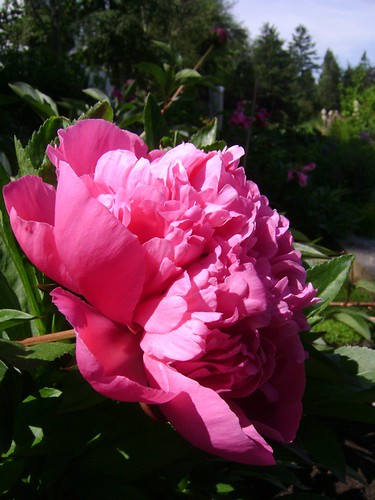Seven Fragrant White Flowers for Shavuot
Shavuot is beginning this evening, and to celebrate, I've put together a bouquet of 7 white flowers that are currently in bloom. Wearing white is a Shavuot tradition, and so is wearing wreaths of flowers on the head. When I was a little girl, this was the time of the year when fragrant roses will be in full bloom, and the children lucky enough to grow them in their garden will have a flower or two of deep, wine-coloured burgundy rose in their baskets of first fruit - alongside apricots and green almonds. I am grown up enough now to own up to it and say I was deeply jealous of their baskets, and couldn't keep my nose away from it. This collection of seven flowers will not include white rose (or jasmine, for that matter) because I would like to make room for less known white flowers and hope that you find this post inspiring and alluring.
1. White Peony:
I find the white variety to be more well-rounded. White peonies smell a little more heady than the pink and a tad jasmine-y but still also peppery and fresh. There is a strong resemblance to lily of the valley, and also there's a hint of hyacinth's heady floral and sharp green-onion-y notes. The flowers fills the room with their beautiful scent for a full week after being brought home from the florist. The pink ones are a bit of a hit-and-miss. Some smell rosy and with a hint of spicy carnation note; others are more green and dewy; and some smell funky, like rotten vegetables...
There is no shortage of peony-themed fragrances, but non has captured my nose as of yet. If you have any recommendations, I'll be happy to try them!
2. Choisya "Aztec Pearl" (aka Mexican Mock Orange)
Smells more like heliotropin than orange blossom to me, but is related to the same family (Rutaceae). The flowers have a powdery-sweet aroma with hints of methyl anthranilate. Very soft and alluring. I only know of one fragrance that is centred around it - Choisya candle by Dyptique.
3. Black Locust (Robinia pseudoacacia):
The black locust tree is native to the Southeastern United States, but have found its way to many a gardens across the world, where it has become naturalized (and in some cases invasive) in temperate North America, Europe, South Africa, Asia. The origin of the name: Because of their similar fruit shape, Jesuit missionaries confused it with the carob tree Carob Tree (Ceratonia siliqua).
The flowers have a havenly sweet-pea aroma mingled with the scent of intensified orange blossom. The methyl anthranilate aspect really coming through like a candy from the gods in this tree flower from Fabaceae family. The flowers are edible, having a sweet and aromatic flavour, but the fruit is not (though some say the seeds are edible too). Try using the flowers in a sugar syrup for desserts, or crystallize them in a similar way that rose and violet petals are treated. The entire flower clustered are dipped in batter and deepfried into fritters!
I'm currently experimenting with some black locust syrup and tinctures recipes, and will report to you once they've rendered successful (which they are bound to be! The syrup is already tasting amazing halfway through the maceration process).
4. White Carnation (Dianthus):
Dianthus seems to be the flower of the season, popping up in many gardens in the West End this year more than I've ever seen it before. I finally planted my own two Dianthus "Coconut Surprise" plants in my balcony's forelorn planter. They will only go till the end of fall, and I plan to thoroughly enjoy them!
I've gone into much detail about the scent of carnation. The white variety is what's mostly used for carnation absolute production for perfumery. The flowers have a beautiful, sweet-warm and soft-powdery scent and I can't help myself but get on my knees to smell everyone I meet on my walks in the neighbourhood.
Favourite carnation perfumes: InCarnation, Bellodgia,
5. Philadelphium:
To my nose, Philadelphium smells like fedjoia - fruity, exotic, edible and unusual.
Is is also known as Mock Orange, but is a different plant than Choisya, and smells completely different.
6. White Magnolia (Magnolia × wieseneri):
This particular magnolia has a magical scent. According to Wikipedia:
"Its most notable feature is the remarkable fragrance of the ivory-coloured flowers, which has been likened to pineapples and seen adjectives such as "ethereal", "spicy" and "aromatic" used". It significantly changes its scent throughout the day, smelling like a dewy jasmine-tea in the evening, and developing a more fruity-aldehydic and lactonic character during the day, reminiscent of peach (aldehyde C-14) and a fatty, oily-skin-like scent (aldehyde C-13) during the day and once the flower is "overripe".
Favourite magnolia perfumes: New Orleans, Opium Fleur de Shanghai.
7. White Lilac:
White lilac has more indole than the purple or pink ones, giving them a more perfumey character. Additionally, lilacs have the scent of powder, hints of green fig and cucumber, and in many cases also a rather dominant styrene presence.
Favourite lilac perfumes: Ineke's After My Own Heart and Olivia Giacobetti's En Passant (for Frederic Malle Editions de Parfum).
If you want to celebrate Shavuot with the traditional desserts, here are my recipes for the perfect blintzes and best ever cheesecake!




